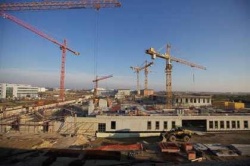MedAustron is becoming a reality in Wiener Neustadt
Currently there is a truly enormous hole in the ground in the city of Wiener Neustadt, Austria, but by summer 2012 MedAustron, one of the most modern centres for ion therapy and research in Europe, is to be built here.

After two treatment centres in Germany failed, gaining from the experience and failure in others, this €200 million MedAustron project will be one of four ion therapy centres worldwide to offer treatment with protons as well as carbon ions Ion therapy is considered a great beacon of hope in cancer care – especially for tumours with no hope for a long time.
So far around 70,000 patients worldwide have received radiotherapy with ions. This includes treatment with protons as well as carbon ions. ‘This therapy is physically very different from conventional photon radiotherapy and is characterised by increased, relative biological effectiveness,’ explained Professor Ramona Mayer, project head at MedAustron. ‘The specific physics of the ray allows an even more targeted application of the dose to a certain tumour area. Patients with slow-growing, radiation-resistant tumours, or tumours in close proximity to radiation-sensitive organs, will particularly benefit from this procedure which is the ideal complement to chemotherapy and surgery in these cases.’
The ions have to be accelerated to up to 70% of the speed of light with the help of a particle accelerator.
Financed by the Republic of Austria, the state of Lower Austria and the City of Wiener Neustadt, the MedAustron Centre is banking on 50 years of experience gained by the European Organisation for Nuclear Research (CERN) in Geneva, Switzerland, the largest Institute for Particle Physics worldwide, for the implementation of its own acceleration technology.
‘The accelerator at MedAustron will basically work just like the world’s largest particle accelerator, the LHC, used for the recent big bang experiment at CERN,’ explained Dr Bernd Mosslacher, Managing Director of MedAustron. ‘The design which originated from the so-called Proton-Ion Medical Machine Study (PIMMS) is based on a synchrotron, a circular accelerator with a circumference of around 80m, which accelerates the particles to high speeds.’ 40 MedAustron staff members spent several years working at CERN on the conception of the particle accelerator facility.
With the product development completed, the building phase is in full swing. The new facility will consist of an accelerator area, treatment area which, next to three treatment rooms with two horizontal-l and one vertical fixed beam, will also have a treatment room with a proton gantry, i.e. a mobile radiation unit, as well as its own research area where the knowledge of radiation biology and medical radiation physics is to be broadened. Once the building works have finished the installation of the individual accelerator components will commence. ‘We expect to be operational in 2013, with the first patients to be treated in 2015,’ Prof. Mayer hopes. ‘This will be an exciting moment as the complex interaction between the accelerator, medical
technology and control software can only succeed if all components work together harmoniously. Any problems likely to occur will be in this area. This is the point where most other ion therapy centres have experienced delays.’
Dr Mosslacher: ‘We’ve definitely not experienced the technical problems that created so many difficulties in those centres. In hindsight it was the right decision that we didn’t bank on cooperation with industry but with a scientific research centre like CERN. The economic pressure associated with a purely commercially driven facility is obviously a lot more intensive than with our infrastructure project, which is to serve medicine and research.’
Apart from the combined ion therapy centre in Wiener Neustadt there is a further Italian facility under development at the National Centre of Oncological Hadron Therapy (CNAO) in Pavia, the MedAustron Managing Director reports. ‘The MedAustron and the CNAO Centre are technologically similar and are both based on the PIMMS design of CERN. However, our colleagues at the CNAO will be ready to treat cancer patientsbefore us. We look at Pavia as a type of Proof-of-Concept of our own installation – if the clinical application succeeds there we are also likely to be successful.’
Further combined facilities for protons and carbon ions have been operational in Hyogo, Japan since 2005 and in Heidelberg, Germany since 2009 respectively. So far only 10% of patients who have undergone ion therapy have also received treatment with carbon ions. The procedure initially underwent a long study period in Japan, under strict monitoring of the dose escalation steps, before it was licensed. However, the local treatment results are tremendous, Prof. Mayer reports. ‘The procedure is basically indicated for all oxygen poor tumours situated in the vicinity of high risk organs, such as liver, pancreas or prostate tumours. The radiation exposure in the healthy tissue surrounding the tumour drops rapidly and the tissue behind the tumour is almost completely spared.
‘Especially in the treatment of children and adolescents, for whom even a small dose can lead to longterm consequences and side effects, proton therapy will certainly have a bright future. Moreover, there are already first concepts, such as at the Barnes-Jewish Hospital in St. Louis/Missouri, to scale down the particle accelerator to such a size that it will be possible to install it in a hospital. In this way, ion therapy could become much more widely established. We are therefore only at the beginning of what will be possible with this novel technology.’
22.02.2012











